
Exchange-種を植える
2013年10月26日(土)~12月15日(日)
air2013-3ja
リンダ・ハフェンシュタイン
Linda HAVENSTEIN
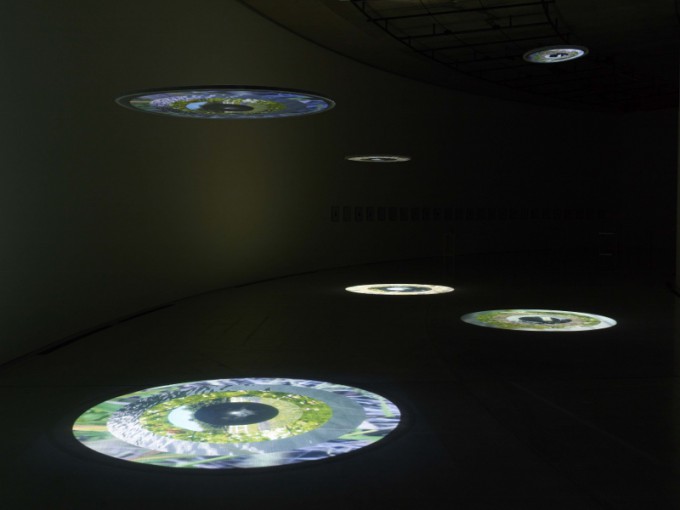
《cosmos with you in the center of everything (and me as mercury)》(あなたが中心にいる宇宙 そして私は水星) 撮影:山本糾
ドローイング的探求により描出される身体空間
服部浩之
リンダ・ハフェンシュタインは、彼女を取り巻く様々な人の影響を受け、それを吸収し、自身の生きる術としての哲学の探求と、彼女にとって最も身近で謎でもある身体の内部空間を思考するための作品群を制作している。映像などを主なメディウムとするが、ドローイング(線描)をその創作活動の出発点にもつ彼女は、どこかドローイング的な様相の作品を制作している。つまり、なにかを完成させるというより、自身が関心を抱く事柄に輪郭を与えるような態度で、様々な描線の実験をしている印象が強い。それは生きる姿勢として非常に素直で実直で、彼女自身の態度表明とも言えるだろう。
今回のレジデンスでは、身体空間を模索する二点の作品を完成させた。
この二つは対照的なもので、一方は身体そのものや、その距離感を客観的にかたちに落とし込むものとして、もう一方は彼女自身の身体空間をより主観的に探究するものとなった。前者に対応する《首都から極北の星座》(fig.1)は、青森滞在直後に発見した彼女にとって印象的だった人の「動作」を変換して作品化したものだ。モチーフは、原子力関連施設建設に反対し座り込む老婆3人の姿を捉えた写真、口寄せをするいたことそのことばを受ける2人の人の写真、そして市内の看板に発見した馬を引く2人の人と、その選択に強い根拠はないが、モチーフを変換し描出する方法が非常に興味深い。収集した8名の動作の輪郭線を描きだし、各動作に対応するよう8名の生身の人間にそれぞれ同じポーズをとってもらい、個別に写真撮影する。ここで撮影するのは、単純に動作の姿だけでなく、その人の精細な身体的特徴である。モデルには裸体になってもらい、その身体にある無数のほくろや染みなど身体の暗部を捉える。身体の輪郭は人によって全く違う曲線を描く。そしてどんな人にも必ず染みやほくろはあるが、もちろんそれも大きさやかたちなどすべて異なる。次に彼女は撮影した身体のほくろや染みのみを丁寧に抽出していく。可能な限りすべてのほくろなどを抽出することで、人の身体の輪郭はぼんやりと現れる。そして、身体の暗部により描かれた8名の動作をひとつの黒色の画面上に構成し(fig.2)、すべての暗部の点を、穴を穿つことで抜き出していく。最後にその漆黒の面の背後に光を落とすと、まるで星空のような情景が現れる。抜き出された暗部は身体の輪郭をも現し、それは夜空の星座群のようにも見える。「自分自身で見ることができず、その広がりを知覚することができない身体の内部は無限のように感じられ、それは宇宙空間のようだ」(1) とハフェンシュタインは言う。彼女のこの身体に対する意識は、動作を発見すること、その動作を全く別の人間がなぞること、その別の人間の身体を撮影し暗部を捉えること、その暗部の点すべてに穴を穿つこと、そして暗部に光にかえることという、何重もの変換を与えることで身体空間を客観的に描出したものだ。つまり、マクロコスモス(=宇宙)に対して、人間の身体をミクロコスモス(=小宇宙)と考える「身体の宇宙」という思考の逡巡を、変換と抽出の手法によりかたちにした作品だ。
一方で、《あなたが中心にいる宇宙 そして私は水星》(fig.3)は、身体空間をより主観的な方法で描出する作品だ。この作品はある種の見立てにより構成されている。上述の作品とは異なり、基本的に身体のなかの小宇宙(ミクロコスモス)とその眼前に存在する世界(マクロコスモス)の関係を、彼女自身の身体を中心として思考したプロセスをかたちにしたものだ。太陽系の構造に類比し、正円の平面形を描くACAC展示棟を太陽に見立て、そのサイズから太陽系の惑星の軌道を相似形で割り出していった(fig.4)。例えば水星の位置は、地図上でACACを基準として算出されたある地点の同心円上の軌道であり、その軌道上を彼女自身が移動する。水星の軌道上を移動する彼女からはACACは太陽のように見えてくる。そのような法則に則り、金星に位置する軌道、地球に位置する軌道などの太陽系上の軌道を実際に歩き、映像に収める。そしてそれを軌道順に重ねていきレイヤー状の映像を描く。それを天井から床面に向けて投射する。また中空にも半透明のスクリーンを設置することで、床面だけでなく中空にも像を浮かべる。彼女自身がある惑星となりその軌道上を歩くことで、太陽系を描き出す。これは身体の宇宙と太陽系という宇宙をひとつの作品上で、共存させるものだ。惑星そのものを体現した彼女の主観的な身体は、ひとつの小宇宙であり、同時にその移動の軌跡が描きだすのはコスモスである。この作品は、身体宇宙をより主観的に彼女自身の身体を介して描きだすドローイングと言えよう。
ドローイングとは、ある種の習作、あるいは蓋然的記述と言えるが、彼女の作品制作は、その感覚が非常に強い。アウトプットの形態よりは、作品を展開するための方法論や論理を先行させ、かたちにしていくプロセスをより重要視し、とにかく自身のロジックに則って描いてみるということを試している。それは、本当は非常に重要なことで、正常な欲求である。近年誰もがたくさんの情報を容易に収集できるようになり、その作品化のモチベーションや根拠が不在のまま、最終的な作品らしきアウトプットのみが達者なものを多数散見する。公に発表するうえで、その技術は重要なものであるが、ハフェンシュタインのように彼女自身から発する絶対的な探究の根拠は忘れ去られてはならないものだ。ときにそれは「未熟さ」の露見となってしまうかもしれないが、その未熟さには別の可能性が秘められているだろう。もちろん彼女が自身の内側で組み立てている論理を、現在の作品形態で最大限体現できているかというと、それはかなり荒い部分もあるし、まだまだこれから洗練されるべき点は多数ある。しかしレジデンスとは、本質的にそのような未だ芽吹いていない可能性の種を蒔き続けることができる貴重な実験の場と時間を獲得できる機会なので、その機に蓄積した思考のプロセスを今後どのように出力していくか期待されるところだ。尽きない身体への探求の精神は、今後いかなるかたちに結実していくのだろうか。ハフェンシュタインの、身体空間を探求することで概念としてのコスモスを描出する思考のドローイングの成熟に期待したい。
(1) リンダ・ハフェンシュタインへのインタビューより (2013年11月29日ACACにて。『AC2』no.15掲載)。
 《far north of the capital zodiac》(首都から極北の星座) 撮影:山本糾
《far north of the capital zodiac》(首都から極北の星座) 撮影:山本糾
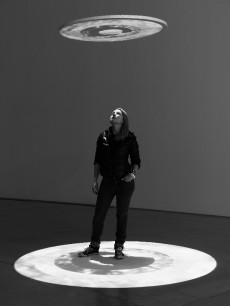
撮影:山本糾

fig.1

fig.2
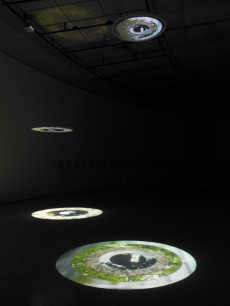
fig.3
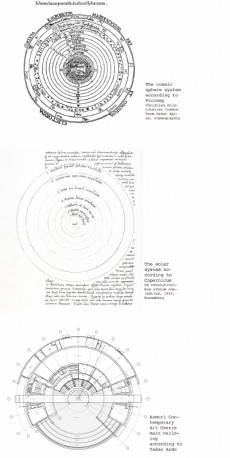
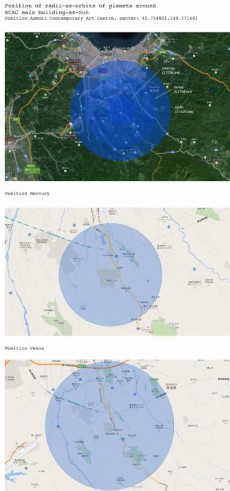
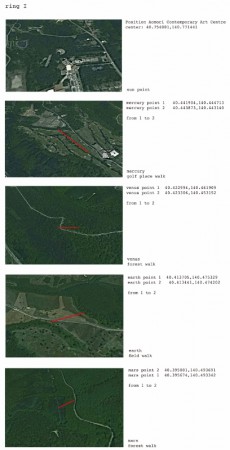
fig.4
Exchange ―Planting the seed
October 26 – December 15, 2013
Linda HAVENSTEIN
リンダ・ハフェンシュタイン

cosmos with you in the center of everything (and me as mercury) photo: YAMAMOTO Tadasu
Bodily space explored by drawings
HATTORI Hiroyuki
Having absorbed the influence from many dif ferent people surrounding her, Linda HAVENSTEIN has been creating a series of artworks in order to pursue philosophy as a means to live by and to think about inside of the body, which is right there but mysterious to her. Though video is her major medium, she started out as an artist with drawings. That is why her works still have aspects of drawing. In other words, her works give us an impression that she is experimenting with drawing lines in various ways as if to give a contour to something she is interested in, rather than trying to mold a piece of work. There, her sincere, honest attitude towards life seems to be expressed.
For the residency program this time, she produced two works groping for the bodily space. There is a contrast between the two: in one of them, she tried to express the body itself or put a body-related distance into a form, while the other shows her relatively subjective pursuit of her own bodily space. In the former, “far north of the capital zodiac”(fig.1), some impressive movements of people which she captured just after she came to Aomori are transformed into the work. The motifs include a photograph of three old women who staged a sit-in against the construction of nuclear-related facilities, a picture that shows a necromancer and two persons communicating with her, and a picture of two men pulling a horse that was painted on a signboard she found in the city. I don’ t think her choice of the subjects is based on anything particular, but I find her way of converting and depicting motifs very interesting. After tracing the contours of those eight moving people she chose, she asked eight real people to pose in the manner that corresponded to each of the above-mentioned motifs, and photographed them separately. Here, what she aimed to photograph was not merely their moving images but their delicate bodily features. The models were asked to pose nude so that she could capture their flaws such as moles and blotches. Different people have totally different body contours. Everybody has moles and blotches, but their sizes and shapes are different. Then she carefully extracted only moles and blotches out of the photographed bodies. When she obtained them as many as possible, there appeared the vague outline of a human body. Then the frozen movements of the eight people depicted by their flaws were arranged on a flat dark screen (fig.2), and each spot was drilled into a hole. Lastly, when light was shed on the pitch-dark screen from behind, there emerged a sight just like a starlit sky. The flaws showed the body contour and looked like the constellation in the night sky. Havenstein remarked, “The inside of our body which we can’ t see and is difficult for us to perceive seems to be infinite like outer space.”(1) With this consciousness of the body, she focuses on people’ s movements that are copied by others, photographs their bodies, captures their flaws, drills a hole in each spot, and sheds light on the flaws. Thus, the bodies are objectively depicted through multiple conversions. In other words, by comparing the human body to the microcosm in relation to the macrocosm of the universe, the process of her thinking of “the cosmos in the body” is made into this work through conversions and extractions.
In her work “cosmos with you in the center of everything (and me as mercury)” (fig.3), on the other hand, space surrounding the body is depicted more subjectively. The composition of this piece is based on likening in a sense. In this piece, different from the above-mentioned work, her thinking process is put into a form. With her own body in focus, she thinks of the relationship between the microcosm of the body and the macrocosm of the world, which exists before it. As in the solar system, she likens the plane shape of a perfect circle of the ACAC exhibition wing to the sun, and calculates the orbits of the solar planets based on a proper reduced scale. (fig.4) Mercury, for instance, is positioned on the orbit on the concentric circle computed around ACAC on the map. As she moves along the orbit of Mercury, ACAC appears to be the sun. Acting on such a rule, she actually walks on the orbits in the solar system such as the orbit of Venus and the orbit of the Earth, and she films what she sees. Then she piles them up in the order of the orbits and produces layered images, which are projected onto the floor from the ceiling. In addition, the images emerge not only on the floor but also in mid air on a translucent screen. As she walks on the orbit acting as a planet itself, she depicts the solar system. It means that the cosmos of the body and the cosmos of the solar system are made to coexist in her single work. Her body, which embodies a planet subjectively is a microcosm and at the same time, the locus of her movements draw the cosmos. One might say that this piece is a drawing depicting subjectively the cosmos of the body through her own body.
A drawing can be explained as kind of a study for exercise or a probable description, and I find a lot of this aspect of drawing in her production. As the methodology and logic for developing her work come before the form to be displayed, more importance is placed on the process of formation. Anyhow she tries to draw in conformity with her own logic. It is, I believe, very important and her intention is normal. In recent years, because everyone can collect a lot of information easily, I come across many pieces that would pass as finished works giving no indication of a motive or the basis for creation. Though the technique is important when a work is publicly displayed, we should not forget that there must be the absolute basis for pursuit as Havenstein shows us. It might reveal “immaturity” at times, but probably there is another possibility hidden there. To answer a question whether or not the logic based on her own thinking is embodied to the utmost in her current work, I would say that there are rough parts and many aspects that should be refined further in the future. The residency project is originally designed to provide valuable time and opportunities for experimental works nurturing the potential of various talents. So how she would output her accumulated thinking would be worth watching in the future. How will her inexhaustible enthusiasm for pursuing the body come to fruition in her work? I expect that she will fully develop her drawing of the cosmos as a concept by pursuing the bodily space.
(1) Interview with Linda HAVENSTEIN on November 29, 2013 at ACAC (Aomori: AC2, No.15)
 far north of the capital zodiac. photo: YAMAMOTO Tadasu
far north of the capital zodiac. photo: YAMAMOTO Tadasu

photo: YAMAMOTO Tadasu

fig.1

fig.2

fig.3



fig.4
